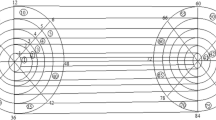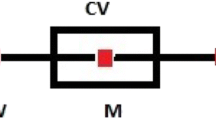Abstract
Oocyte and egg provide an excellent model system for studying calcium patterns. Calcium signal is a transient increase of intracellular calcium concentration which influences different cellular processes among a variety of different cells. The change in calcium concentration transmits information through an organized set of spatio-temporal changes, localized transients or puffs, calcium wave propagation, and global oscillations. During oocyte maturation, the calcium signalling machinery undergoes differentiation which results in distinctly different calcium release patterns on all organizational scales from puffs to waves. It is crucial to understand the mechanics of calcium regulation in cytosol of oocytes, to have better understanding of fertilization process. In this paper, a finite-element model using coaxial circular sector elements has been developed to study two-dimensional calcium distribution in oocytes. Appropriate initial and boundary conditions are incorporated in the model based on biophysical conditions of the problem. A computer program has been developed in MATLAB 7.10 for the whole problem and executed on Intel(R) Core™ i3 CPU, 4.00 GB RAM, 2.40 GHz processor to obtain numerical results. These results have been used to study the relationship of calcium concentration with parameters like Na+/Ca2+ exchanger, Na+/K+ pump, RyR calcium channel, SERCA pump, and buffers. It is observed that there is significant variation in calcium profiles due to the effect of Na+/Ca2+ exchanger, Na+/K+ pump, RyR calcium channel, SERCA pump, and buffers. The results give us the better insights of coordinated effect of Na+/Ca2+ exchanger, Na+/K+ pump, RyR calcium channel, SERCA pump, and buffers on calcium distribution in oocytes.






Similar content being viewed by others
References
Andressen C, Blumcke I, Celio MR (1993) Calcium-binding proteins: selective markers of nerve cells. Cell Tissue Res 271:181–208
Backx PH, Tombe PPD, Deen JHV, Mulder BJ, Keurs HET (1989) A model of propagating calcium-induced calcium release mediated by calcium diffusion. J Gen Physiol 93(5):963–977
Berridge M, Lipp P, Bootman M (2000) The versatility and universality of calcium signalling. Nat Rev Mol Cell Biol 1:11–22
Berridge M, Bootman M, Roderick H et al (2003) Calcium signalling: dynamics, homeostasis and remodelling. Nat Rev Mol Cell Biol 4:517–529
Bootman MD, Berridge MJ, Roderick HL (2002) Calcium signalling: more messengers, more channels, more complexity. Curr Biol 12:R563–R565
Carroll J (2000) Na+/Ca2+ exchange in mouse oocytes: modifications in the regulation of intracellular free Ca2+ during oocyte maturation. J Reprod Fertil 118:337–342
Cheng H, Lederer W (2008) Calcium sparks. Physiol Rev 88(4):1491–1545
Dargan SL, Parkar I (2003) Buffer kinetics shape the spatiotemporal patterns of IP3-evoked Ca2+ signals. J Physiol 553:775–788
Falcke M (1999) Inositol 1,4,5-trisphosphate induced calcium waves. Transp Struct Lect Notes Phys 532:164–190
Falcke M, Li Y, Lechleiter JD, Camacho P (2003) Modeling the dependence of the period of intracellular Ca2+ waves on SERCA expression. Biophys J 85(3):1474–1481
Fijuoka Y, Hiroe K, Matsuoka S (2000) Regulation kinetics of Na+/Ca2+ exchange current in guinea pig ventricular myocytes. J Physiol 529:611–623
Han JM, Tanimura A, Kirk V, Sneyd J (2017) A mathematical model of calcium dynamics in HSY cells, PLoS Comput Biol 13(2):e1005275
Hatano A, Okada J, Washio T, Hisada T, Sugiura S (2011) A three-dimensional simulation model of cardiomyocyte integrating excitation–contraction coupling and metabolism. Biophys J 101:2601–2610
Jafri MS (1995) A theoretical study of cytosolic calcium waves in xenopus oocytes. J Theor Biol 172:209–216
Jha A, Adlakha N (2015) Two-dimensional finite element model to study unsteady state Ca2+ diffusion in neuron involving ER LEAK and SERCA. Int J Biomath 8(1):1–14
Kaouri K, Chapman SJ, Maini PK (2014) Mathematical modelling of calcium signalling taking into account mechanical effects. J Bioenerg Biomembr 46(5):403–420
Kumar H, Naik PA, Pardasani KR (2017) Finite element model to study calcium distribution in T lymphocyte involving buffers and ryanodine receptors. Proc Natl Acad Sci India Sect A Phys Sci 88(2):1–6
Machaty Z, Ramsoondar JJ, Bonk AJ, Prather RJ, Bondioli KR (2002) Na+/Ca2+ exchanger in porcine Oocyte. Biol Reprod 67:1133–1139
Marhl M, Haberichter T, Brumen M, Heinrick R (2000) Complex calcium oscillations and the role of mitochondria and cytosolic proteins. Biosystems 57:75–86
Mattson M (2018) ER calcium and Alzheimer’s disease: in a state of flux. Sci Signal 3(114):pe10
Matveev V (2018) Extension of rapid buffering approximation to Ca2+ buffers with two binding sites. Biophys J 114:1204–1215
Means S, Smith AJ, Shepherd J, Shadid J, Fowler J, Wojcikiewicz RJH, Mazel T, Smith GD, Wilson BS (2006) Reaction diffusion modeling of calcium dynamics with realistic ER geometry. Biophys J 91:537–557
Naik PA, Pardasani KR (2013) One dimensional finite element method approach to study effect of ryanodine receptor and serca pump on calcium distribution in oocytes. J Multiscale Model 5(2):1–13
Naik PA, Pardasani KR (2014) Finite element model to study effect of Na+/K+ pump and Na+/Ca2+ exchanger on calcium distribution in oocytes in presence of buffers. Asian J Math Stat 7(1):21–28
Naik PA, Pardasani KR (2015a) Two dimensional finite element model to study calcium distribution in oocytes. J Multiscale Model 6(1):1–15
Naik PA, Pardasani KR (2015b) One dimensional finite element model to study calcium distribution in oocytes in presence of VGCC, RyR and buffers. J Med Imaging Health Inform 5(3):471–476
Naik PA, Pardasani KR (2016) Finite element model to study calcium distribution in oocytes involving voltage gated calcium channel, ryanodine receptor and buffers. Alex J Med 52(1):43–49
Neher E (2000) Calcium buffers in flash-light. Biophys J 79:2783–2784
Panday S, Pardasani KR (2013) Finite element model to study effect of advection diffusion and Na+/Ca2+ exchanger on Ca2+ distribution in oocytes. J Med Imag Health Inform 3(3):374–379
Panday S, Pardasani KR (2014) Finite element model to study the mechanics of calcium regulation in oocytes. J Mech Med Biol 14:1450022
Roberts WM (1994) Localization of calcium signals by a mobile calcium buffer in frog saccular hair cells. J Neurosci 14:3246–3262
Roderick HL, Cook SJ (2008) Ca2+ signalling checkpoints in cancer: remodelling ca2+ for cancer cell proliferation and survival. Nat Rev Cancer 8(5):361–375
Santella L, Lim D, Moccia F (2004) Calcium and fertilization: the beginning of life. Trends Biochem Sci 29(8):400–408
Schwaller B, Meyer M, Schiffmann S (2002) New functions for old proteins: the role of the Ca2+ binding proteins calbindin D28K, calretinin and parvalbumin in cerebellar physiology, studies with knockout mice. Cerebellum 1:241–258
Smith GD (1996) Analytical steady state solution to the rapid buffering approximation near an open Ca2+ channel. Biophys J 71:3064–3072
Smith GD, Dai L, Miura RM, Sherman A (2000) Asymptotic analysis of buffered calcium diffusion near a point source. SIAM J Appl Math 61:1816–1838
Snyder SM, Palmer BM, Moore RL (2000) A mathematical model of cardiocyte Ca2+ dynamics with a novel representation of sarcoplasmic reticular Ca2+ control. Biophys J 79:94–115
Solovey G, Dawson SP (2010) Observable effects of Ca2+ buffers on local Ca2+ signals. Phil Trans R Soc A 368:5597–5603
Stern MD (1992) Buffering of calcium in the vicinity of a channel pore. Cell Calcium 13:183–192
Tewari S (2012) The sodium pump controls the frequency of action-potential induced calcium oscillations. Comput Appl Math 31(2):283–304
Tewari S, Pardasani KR (2010) Finite element model to study two dimensional unsteady state cytosolic calcium diffusion in presence of excess. IAENG J Appl Math 40(3):1–5
Tewari V, Tewari S, Pardasani KR (2012) A model to study the effect of excess buffers and Na+ ions on Ca diffusion in neuron cell. World Acad Sci Eng Technol 62:851–856
Tombes RM, Simerly C, Borisy GG, Schatten G (1992) Meiosis, egg activation, and nuclear envelope breakdown are differentially reliant on Ca2+, whereas germinal vesicle breakdown is Ca2+ independent in the mouse oocyte. J Cell Biol 117:799–811
Tripathi A, Adlakha N (2013) Finite element model to study calcium diffusion in a neuron cell involving. J Appl Math Inform 31(5–6):695–709
Ullah G, Jung P, Machaca K (2007) Modeling Ca2+ signaling differentiation during oocyte maturation. Cell Calcium 42(6):556–564
Wagner J, Keizer J (1994) Effects of rapid buffers on Ca2+ diffusion and Ca2+ oscillations. Biophys J 67:447–456
Weer PD, Gadsby DG, Rakowski RF (2001) Voltage dependence of the apparent affinity for external Na+ of thee backward running sodium pump. J Gen Physiol 117(4):315–328
Acknowledgements
The first author is highly thankful to Dr. S. G. Tewari visiting Scientist Michigan University, USA for his valuable suggestions about finite-element modelling and MATLAB coding of the calcium diffusion problem which helped him lot to develop the code for the present problem.
Author information
Authors and Affiliations
Corresponding author
Rights and permissions
About this article
Cite this article
Naik, P.A., Pardasani, K.R. 2D finite-element analysis of calcium distribution in oocytes. Netw Model Anal Health Inform Bioinforma 7, 10 (2018). https://doi.org/10.1007/s13721-018-0172-2
Received:
Revised:
Accepted:
Published:
DOI: https://doi.org/10.1007/s13721-018-0172-2




